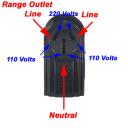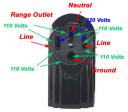
From L to R: Congressman Ron Paul!, Mike Faiella, A Guy, Fr. Andrew Tregubov (my priest), Samurai Appliance Repair Man. Not shown: Mrs. Samurai— she’s taking the picture (click to enlarge).
Monday, December 3, 2007
BJ Bricker’s Restaurant, Claremont, NH
I just found out last Friday that I was going to this lunch. What a rare and unique opportunity to talk with an actual presidential candidate! And not just any candidate either; I was having lunch with the man who could very well become the next commander-in-chief.
As we were eating and making small talk, I waited for just the right moment to ask my question. Then, as the waitress was pouring more coffee for everyone, I got my chance.
“So, Dr. Paul,” I began in my best Perry Mason imitation, “I run an appliance repair website, Fixitnow.com, perhaps you’ve heard of it…?”
“No, never heard of it,” he answered.
“Oh well,” I replied, “your loss. Anyway, I get email from thousands of people everyday complaining about their broken appliances. What’s the gubmint gonna do about this?” I asked, indignantly.
“Do about what?” he asked back.
“‘About what?’ About all these broken appliances, that’s what!” I struggled to keep my voice down– I was *really* getting hot now. Was he dissin’ me?
Dr. Paul shot a puzzled glance to his campaign manager. I could tell by the expression on his face that he was thinking to himself, “Wow! This guy’s really good! How do I answer this?” Yep, I had him right where I wanted him.
But instead he said, “I don’t think the government has any business doing anything about yours or anyone else’s broken appliance appliances. Things break. If you get the government involved in it, they’ll just break more often, stay broken longer, and be more expensive to fix.”
“Yes, things break,” I replied with narrowing eyes, “and that’s exactly why we need gubmint to take over this vital issue because no one’s better at breaking things than the federal gubmint.” I paused for dramatic effect. Dr. Paul was looking at the other people seated at the table. “We need to create a new Department of Appliantology and elevate it to a cabinet-level position. Are you willing to create the new DOA for the Ameedican sheople, Dr. Paul?” I was smelling blood as I moved in for the kill.
“Department of Appliantology?” he was sounding a little irked now. “Are you on medication? I don’t even know what ‘appliantology’ is but I promise you this: your ‘Department of Appliantology’ truly is DOA. In fact, I’m going to hack back *all* the alphabet soup bureaucracy in Washington. If I’m elected, the IRS, DEA, BATF, CIA and many others are all going on the chopping block. The size and scope of the federal government will be slashed to a fraction of its present state.”
*SLAM* It was like someone cracking a two-by-four over my head at full swing. I literally jerked backwards and fell over in my chair onto the floor.
In an instant Dr. Paul, a gubmint-licensed physician, was kneeling beside me as I lay flat out on the floor. He checked my pulse and then turned to Mrs. Samurai.
“I’m sorry, Mrs. Samurai, I should have seen it right away; it appears to be a case of cranial rectitis,” he said somberly. “I’ve been seeing it all over the country while campaigning.”
“Cranial rectitis?” Mrs. Samurai asked, her lips quivering slightly. “What is it, Doctor? Is there a cure? Can I get it from the toilet seat?”
“Cranial rectitis is where the victim’s head gets, well, let’s just say it’s not in the right place. The disease causes the victim to believe that he needs government in his life. The cure is to simply hear the message of liberty.”
Then he proceeded to explain that freedom is the birthright of every human being on the planet and that the only legitimate purpose of government is to secure and protect that natural freedom. He explained that the federal government today has become a predator and is herding us like cattle into a increasingly restrictive police state. They do this through the proven tactic of problem-reaction-solution: create or exaggerate a problem – whip up emotional reaction to the problem among the sheople – implement a government solution which always involves infringing on more personal freedoms.
As he spoke, I felt my head begin pulling out of my bottom. Slowly at first, then with increasing strength until it suddenly popped out like a cork shooting off a champagne bottle. I gulped in the air like a prisoner who just tunneled his way out of jail. I was cured; I was free man and I knew it!
Dr. Paul cured my cranial rectitis!
Popping sounds are going off all across the country. Catch the cure! Read more about the miracle cures of Dr. Ron Paul:
Key Issues
Cliff Notes Version
Vote Ron Paul!
 The problem is usually the damper door assembly— these have been a real cash cow, er, I mean, headache for servicers since dayo uno.
The problem is usually the damper door assembly— these have been a real cash cow, er, I mean, headache for servicers since dayo uno. 



